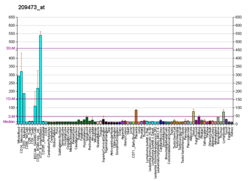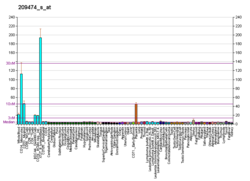ENTPD1
| ENTPD1 | |||||||||||||||||||||||||||||||||||||||||||||||||||
|---|---|---|---|---|---|---|---|---|---|---|---|---|---|---|---|---|---|---|---|---|---|---|---|---|---|---|---|---|---|---|---|---|---|---|---|---|---|---|---|---|---|---|---|---|---|---|---|---|---|---|---|
| Identifiants | |||||||||||||||||||||||||||||||||||||||||||||||||||
| Aliases | ENTPD1, CD39, Cluster de différenciation 39 | ||||||||||||||||||||||||||||||||||||||||||||||||||
| IDs externes | OMIM: 601752 MGI: 102805 HomoloGene: 20423 GeneCards: ENTPD1 | ||||||||||||||||||||||||||||||||||||||||||||||||||
| |||||||||||||||||||||||||||||||||||||||||||||||||||
| |||||||||||||||||||||||||||||||||||||||||||||||||||
| |||||||||||||||||||||||||||||||||||||||||||||||||||
| |||||||||||||||||||||||||||||||||||||||||||||||||||
| |||||||||||||||||||||||||||||||||||||||||||||||||||
| Wikidata | |||||||||||||||||||||||||||||||||||||||||||||||||||
| |||||||||||||||||||||||||||||||||||||||||||||||||||
L'ENTPD1 (pour « Ectonucleoside triphosphate diphosphohydrolase 1 »), ou CD39 (pour cluster de différenciation 39) est une enzyme dont le gène est le ENTPD1 situé sur le chromosome 10 humain.
Rôle[modifier | modifier le code]
Il s'agit d'une protéine transmembranaire permettant l'hydrolyse de l'ATP circulant en ADP puis en AMP[5], inhibant par ce biais la fonction des plaquettes sanguines[6] (l'ADP étant le stimulateur du récepteur P2Y12 plaquettaire, provoquant l’agrégation de ces cellules) ainsi que l'inflammation[7]. Elle existe également sous forme circulante.
Il interagit avec les cavéolines[8], le KLF2[9].
Il est exprimé dans plusieurs tissus, poumons, muscles, reins, cœur, mais pas dans le cerveau[5]. Son expression est augmentée après administration d'un inhibiteur de la phosphodiestérase 3[10].
En médecine[modifier | modifier le code]
Au niveau cardiaque, son expression est augmentée en cas d'ischémie myocardique et il pourrait contribuer à une cardioprotection[11]. Il freine également la formation de l'athérome mais son expression est diminuée dans les zones où le flux sanguin est turbulent[9].
En cas d'hypertension artérielle pulmonaire primitive, le taux de sa forme circulante est augmenté[12].
Notes et références[modifier | modifier le code]
- GRCh38: Ensembl release 89: ENSG00000138185 - Ensembl, May 2017
- GRCm38: Ensembl release 89: ENSMUSG00000048120 - Ensembl, May 2017
- « Publications PubMed pour l'Homme », sur National Center for Biotechnology Information, U.S. National Library of Medicine
- « Publications PubMed pour la Souris », sur National Center for Biotechnology Information, U.S. National Library of Medicine
- Kaczmarek E, Koziak K, Sévigny J et al. Identification and characterization of CD39/vascular ATP diphosphohydrolase, J Biol Chem, 1996;271:33116–33122
- Marcus AJ, Broekman MJ, Drosopoulos JH et al. The endothelial cell ecto-ADPase responsible for inhibition of platelet function is CD39, J Clin Invest, 1997;99:1351–1360
- Kanthi YM, Sutton NR, Pinsky DJ, CD39: interface between vascular thrombosis and inflammation, Curr Atheroscler Rep, 2014;16:425
- Kittel A, Kiss AL, Mullner N, Matko I, Sperlagh B, Expression of NTPDase1 and caveolins in human cardiovascular disease, Histochem Cell Biol, 2005;124:51–59
- Kanthi Y, Hyman MC, Liao H et al. Flow-dependent expression of ectonucleotide tri(di)phosphohydrolase-1 and suppression of atherosclerosis, J Clin Investig, 2015;;125:3027-3036
- Baek AE, Kanthi Y, Sutton NR, Liao H, Pinsky DJ, Regulation of ecto-apyrase CD39 (ENTPD1) expression by phosphodiesterase III (PDE3), FASEB J, 2013;27:4419–4428
- Kohler D, Eckle T, Faigle M et al. CD39/ectonucleoside triphosphate diphosphohydrolase 1 provides myocardial protection during cardiac ischemia/reperfusion injury, Circulation, 2007;116:1784–1794
- Visovatti SH, Hyman MC, Bouis D, Neubig R, McLaughlin VV, Pinsky DJ, Increased CD39 nucleotidase activity on microparticles from patients with idiopathic pulmonary arterial hypertension, PLoS One, 2012;7:e40829







